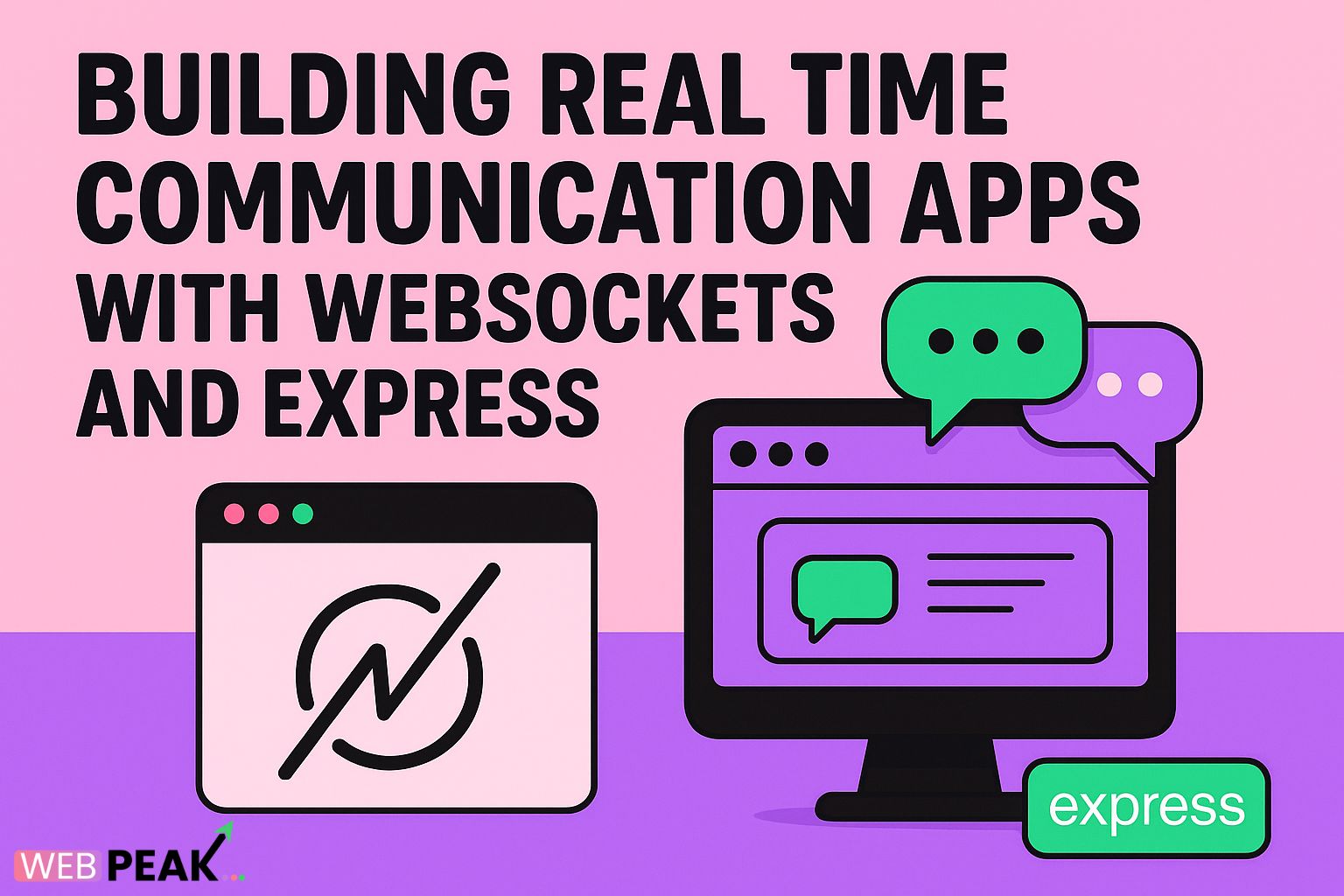Building Real-Time Communication Apps with WebSockets and Express
In today’s hyper-connected world, users expect instant communication — whether it’s a live chat, multiplayer game, or collaborative document editor. The key to enabling these real-time interactions lies in technologies like WebSockets and Express. Together, they allow developers to build fast, reliable, and scalable real-time communication apps that go beyond traditional HTTP limitations. In this article, we’ll explore how to build real-time communication apps with WebSockets and Express, covering the core concepts, architecture, and step-by-step development process, along with actionable SEO tips for developers and businesses.
What Are WebSockets?
WebSockets are a modern web technology that enables two-way communication between a client (such as a browser) and a server. Unlike the traditional HTTP protocol — which requires clients to send a request for every update — WebSockets keep a persistent connection open, allowing the server to push messages to the client in real-time.
This makes WebSockets ideal for building applications that rely on live updates, such as:
- Live chat or customer support systems
- Stock market dashboards or cryptocurrency tickers
- Online multiplayer games
- Collaborative tools (e.g., Google Docs-style editors)
- IoT device data monitoring
How WebSockets Differ from HTTP
In HTTP, communication follows a simple request-response pattern — a client sends a request, and the server responds once. This works fine for static content but fails to handle continuous, bidirectional data flow efficiently. WebSockets solve this by creating a “handshake” that upgrades the connection from HTTP to a persistent TCP connection, allowing data to move both ways anytime without reopening connections.
Why Use Express with WebSockets?
Express.js, one of the most popular web frameworks for Node.js, simplifies server-side development by providing easy routing, middleware management, and integration flexibility. Pairing WebSockets with Express offers a perfect blend of structure and performance:
- Unified Application Stack: Use Express for RESTful APIs and WebSockets for real-time features in a single project.
- Scalability: Express integrates seamlessly with libraries like
socket.io, enabling load balancing and horizontal scaling. - Maintainability: Developers can separate routes, middleware, and WebSocket handlers for clean code architecture.
Combining Express and WebSockets provides a versatile environment for developing modern real-time applications with minimal boilerplate code.
Setting Up the Project Environment
Before diving into code, ensure you have the following installed:
- Node.js (v14 or higher)
- npm (Node Package Manager)
- Basic understanding of JavaScript and Express.js
1. Initialize a Node.js Project
mkdir websocket-express-app cd websocket-express-app npm init -y2. Install Required Dependencies
npm install express socket.io3. Create the Server File
Create a file named server.js and set up a basic Express app integrated with Socket.IO (which simplifies WebSocket management):
const express = require('express');
const http = require('http');
const { Server } = require('socket.io');
const app = express();
const server = http.createServer(app);
const io = new Server(server);
app.get('/', (req, res) => {
res.sendFile(__dirname + '/index.html');
});
io.on('connection', (socket) => {
console.log('A user connected');
socket.on('chat message', (msg) => {
io.emit('chat message', msg);
});
socket.on('disconnect', () => {
console.log('User disconnected');
});
});
server.listen(3000, () => {
console.log('Server running on http://localhost:3000');
});
This setup handles basic events: connection, message broadcasting, and disconnection. Each client can send messages that instantly reach all connected users — a fundamental structure of real-time communication.
Building the Client Interface
Create an index.html file inside your project folder with the following:
<!DOCTYPE html>
<html>
<head>
<title>Real-Time Chat with WebSockets and Express</title>
</head>
<body>
<ul id="messages"></ul>
<form id="form" action="">
<input id="input" autocomplete="off" />
<button>Send</button>
</form>
<script src="/socket.io/socket.io.js"></script>
<script>
var socket = io();
var form = document.getElementById('form');
var input = document.getElementById('input');
var messages = document.getElementById('messages');
form.addEventListener('submit', function(e) {
e.preventDefault();
if (input.value) {
socket.emit('chat message', input.value);
input.value = '';
}
});
socket.on('chat message', function(msg) {
var item = document.createElement('li');
item.textContent = msg;
messages.appendChild(item);
window.scrollTo(0, document.body.scrollHeight);
});
</script>
</body>
</html>
This simple front-end connects to the WebSocket server, sends messages, and displays new messages instantly — all without refreshing the page.
Scaling and Optimizing Real-Time Apps
Once the core functionality is running, developers can enhance performance and scalability. Here are some best practices:
1. Namespace and Room Management
WebSocket servers can define namespaces and rooms to isolate communication channels. This is useful for applications like multi-room chats or collaborative tools.
io.of('/admin').on('connection', socket => {
console.log('Admin connected');
});
socket.join('room1');
io.to('room1').emit('message', 'Hello Room 1');
2. Load Balancing and Scaling
When your app grows, a single Node.js process may not handle thousands of simultaneous WebSocket connections. Consider:
- Using Redis or another message broker for state synchronization across instances.
- Leveraging
socket.io-redisadapter for distributed real-time communication. - Deploying behind load balancers like NGINX or AWS Elastic Load Balancer.
3. Security Measures
Security should never be an afterthought. Implement:
- Authentication: Use JWT (JSON Web Tokens) to authenticate WebSocket connections.
- Rate Limiting: Prevent abuse and spam messages.
- Encryption: Always use
wss://(WebSocket Secure) with SSL certificates in production.
SEO Checklist for Developers Building Real-Time Apps
While WebSockets primarily enhance user experience and engagement, SEO still plays a crucial role for discoverability. Here’s a developer-friendly checklist:
- Use descriptive titles and meta tags for dynamic content pages.
- Render initial content server-side for better crawlability.
- Optimize response times — real-time doesn’t mean heavy payloads.
- Implement proper structured data for event-driven pages.
- Monitor engagement metrics — dwell time improves ranking indirectly.
- Ensure accessibility for users with screen readers and assistive devices.
Common Use Cases of WebSockets with Express
Let’s explore how developers and startups can leverage WebSockets and Express to innovate:
1. Customer Support Chat Widgets
Businesses can create in-website live chat features to offer instant help. With WebSockets, messages appear in real-time without delays or refreshes.
2. Collaborative Platforms
Tools like Trello or Figma rely on synchronized updates. Using WebSockets, multiple users can work together while changes reflect instantly for everyone.
3. Live Streaming and Data Feeds
From sports scores to crypto price tickers, WebSockets push real-time updates efficiently compared to frequent HTTP polling.
4. Multiplayer Games
Express servers can host lightweight multiplayer game logic, while WebSockets transmit instant moves and interactions between players.
Integrating WebSockets into Existing Apps
Adding WebSockets to an already running Express app doesn’t require rewriting the entire backend. Developers can simply extend their server configuration:
const server = http.createServer(app); const io = new Server(server);Then, define WebSocket event listeners to handle messages alongside traditional routes. This hybrid approach enables developers to evolve legacy systems into dynamic, modern platforms without starting from scratch.
Testing and Debugging WebSocket Applications
Testing real-time systems can be tricky. Consider:
- Socket.IO Inspector: Browser extension for monitoring live WebSocket traffic.
- Postman WebSocket Tester: Send/receive test messages without coding.
- Load Testing: Use tools like Artillery or Locust to simulate thousands of concurrent users.
Conclusion
Building real-time communication apps with WebSockets and Express unlocks a new dimension of interactivity and responsiveness for modern web applications. With the right architecture, scalability strategy, and security measures, businesses can deliver seamless real-time experiences that users expect today.
If you’re planning to create or optimize a real-time app for your business, consider partnering with WEBPEAK — a full-service digital marketing company specializing in Web Development, Digital Marketing, and SEO. Their expert team can help you build performance-optimized real-time solutions tailored to your audience.
Frequently Asked Questions (FAQ)
1. What are the main benefits of using WebSockets with Express?
WebSockets provide real-time, bidirectional communication, while Express simplifies backend routing and middleware. Together, they create scalable, efficient applications that respond instantly to user actions.
2. Can WebSockets replace REST APIs?
Not entirely. WebSockets are ideal for live updates and event-driven interactions, while REST APIs are better suited for CRUD operations and structured data retrieval. Many apps use both for maximum flexibility.
3. Are WebSocket connections secure?
Yes, when implemented over wss:// (WebSocket Secure) with SSL/TLS encryption. Always validate tokens and sanitize messages to prevent security threats.
4. What is the difference between WebSocket and Socket.IO?
WebSocket is a protocol, while Socket.IO is a library built on top of it that adds automatic reconnection, multiplexing, and browser compatibility handling, making it easier to work with.
5. How do I scale WebSocket servers?
Use clustering, Redis adapters, and load balancers to distribute WebSocket connections across multiple instances. This ensures stability and performance even with high user traffic.
6. Is SEO affected by using WebSockets?
SEO is primarily affected by how your pages are rendered and loaded. Since WebSocket-driven content updates dynamically, ensure your app serves meaningful static content to search engines initially.





